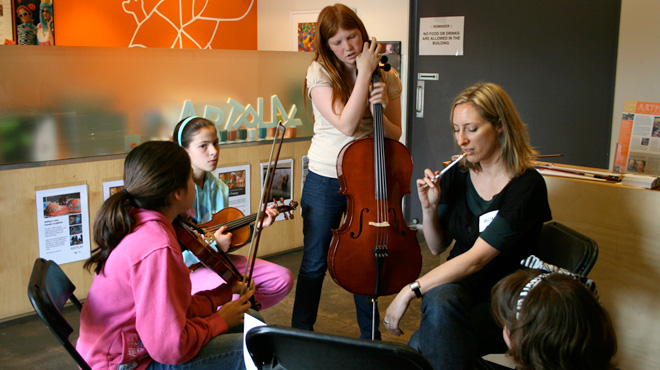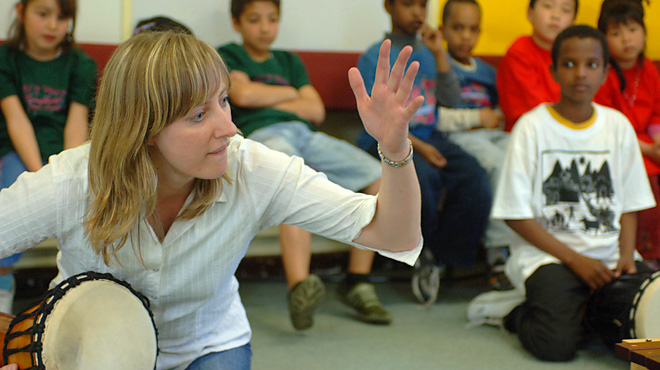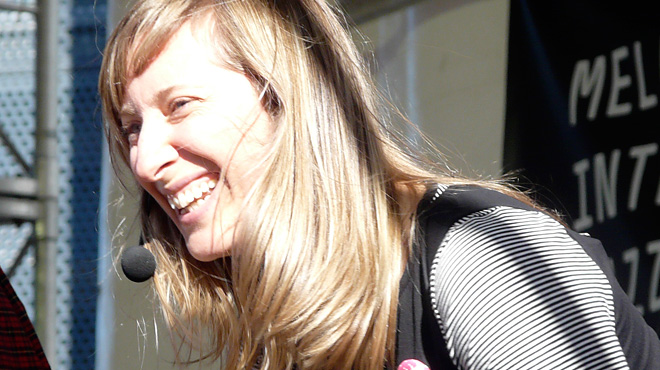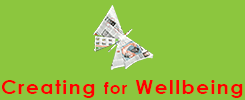Music & Wellbeing
Gillian Howell, musician and music educator writes about how music “connects us with our healthy selves.” She makes the links between shared music making, group composition and ensemble, self-esteem and healthy relationships and talks about her work with newly arrived refugee children in Melbourne.
Inherent Qualities of Music Making & Mental Health
Music is all around us – in the background, the foreground, in buds in our ears. People have responses to music throughout their lives – even babies in the womb have responses to music! This ubiquity and universal point of connection offers teaching artists a powerful shared experience with participants in our projects, and the versatile and chameleon nature of music as an art form lends itself beautifully to an infinite number of approaches.
What is Music and How Does it Work?
Music is sound organised by a human mind with the intention of “meaning” something to anther human mind, and is profoundly communicative in its potential for variety, creativity and complexity (Ansdell 1995, p. 33).
Music is a temporal art form – that is, it exists in time, and so it can carry people along with it. Performers and listeners alike can be “in the moment,” inside every sound, connected to the sounds that you and others make. It’s subjective – it makes sense in different ways to different people, but that doesn’t really matter when you play together in an ensemble. It doesn’t matter if one person thinks the music is depicting a wild storm, and another thinks it is depicting a carnival… those differences don’t need to be discussed or argued. Everyone can have their own personal meaning, and still play together. In this way, it is very accepting and welcoming of difference.
Playing in an ensemble can give people a profound sense of connection. In a music ensemble, everyone has a role, and often an instrument (including voice). Ensemble playing also promotes and requires an intense quality of listening. Even with a conductor, every one is listening to each other, watching for cues, and making small adjustments all the time.
An individual’s part may be in the foreground or the background. The layers present in a piece of ensemble music are changing in relation to each other all the time, and the focus of the audience’s attention may shift around the ensemble, as the layers change. Thus, there are multiple possibilities for different individuals to shine, and to blend in, all in the safe context of the music making.
Music keeps you “in the moment.” It requires a lot of concentration on an essentially abstract, intangible thing – to do it well, you need to stay focused. In many group-devised projects too, it’s not written down – the participants need to work with memory and cues. I think of it as being a bit like “keeping your eye on the ball,” or keeping the ball in constant contact with a hockey stick.
And, if you have been part of creating all the notes, it holds your interest in an even more intense way.

How Do These Qualities Work Towards Health and Wellbeing Outcomes?
There are many ways that I see the music work I am engaged in supporting participants towards strong health and wellbeing outcomes. Here is a list of some of them – you will probably find you could add more, as our own experiences in music are so personal.
- It’s fun, playful, it doesn’t judge, there is room for all skill levels (from just copying and joining in, to performing solos).
- It can take you out of yourself – out of your own head, out of your usual world, and into the present moment.
- It’s not competitive; the effort is going into making everyone sound good.
- It allows for all inner worlds – from those that are filled with words, symbols and concepts, to those that are not.
- Music acts to unite. It doesn’t require an “interpreter” to be enjoyed.
- The process of music grounds us in the present. It may evoke the past, but the act of making music grounds us in the present.
- “Music … can prepare the conditions where a person’s potential can be motivated to unfold in its own unique way, and where the growth can happen in its own time” (Ansdell 1995, p.19). The changes aren’t visible – they are often happening on quite a deep level.
- Oliver Sacks, when discussing working with patients with Parkinson’s Disease, described the way “music, particularly, seems to penetrate the passivity of the illness – it makes the person want to act … this quality of music can quicken the will” (Ansdell 1995, p.17).
While I am quick to point out that the work I am engaged in as a creative artist is not music therapy, I find it useful to consider my practice in the context of what we know about this and other arts therapies. While the premise and intentions of practice will differ from the outset, the actual points at which a creative engagement diverges from a therapeutic intervention may be quite far into the process, in terms of strategies used, and the rules of engagement that the different professionals adhere to.
For example, I draw much inspiration from the notion (learned from music therapists) that music connects with our healthy selves. We don’t need to be anything more than we are, ideally, in a music-making situation. This is not about apologising for what we can or can’t do, or about feeling inadequate. Ansdell talks about arts therapies as “existence therapies,” in that they work directly on the will and on the “existential areas of our experience where we find meaning and beauty. They work with what is integral to a person, not just their handicap or illness” (1995, p.17).
Another quote from Ansdell:
The gifts of improvisation – immediacy, involvement, unpredictability – are balanced by the demands it makes: to listen, to be aware, to dare to create, to remain in the present. These are the opposite of some of the tendencies of many people we work with, to greater and lesser extents. When people find themselves lost in the past, or in an imagined future (as habit or anxiety), they have lost the ability to listen to themselves or others, and tend to have rigid and inflexible patterns of behaviour.
In contrast, improvisation in a music therapy context encourages and cultivates the qualities of awareness, listening and creativity. When music evolves, and improvisation seizes the present, there can emerge the opportunity for a person to experience themselves differently from their habitual state (p.27).
I think that the sense of everyone playing together, in a shared music-making environment, is an incredibly powerful, affirming experience. Sometimes I think (as a non-scientist) that something must be going on at a molecular level – an energetic field that connects each person to the group, held in place by the sounds being generated by the group. Everyone knows when that kind of magic has been present.
The fact that music is often something that many feel a strong desire to be part of is important here. It creates the motivation to participate, and it is perhaps a more benign setting. People can be protected somewhat, by the subjective meanings of music. Offers don’t come in the form of revealing words; they come in the form of musical ideas. They are from yourself, but what they mean for you is just for you to know.

What are the Different Modes of Engagement that You Can Use with Music?
All of my work focuses on group composing – I work with groups of people, of all ages, to devise and perform their own music. We make it up together. This is incredibly important, as there are huge additional benefits that I believe come to people when they participate in music invention, about feeling truly connected to the material, feeling ownership of it, and therefore ownership of the outcome.
When we start from a compositional focus, we take the “raw materials as we find them.” That’s the way I think about it, and by this I mean I don’t put energy in trying to build up skills first (although skills will certainly be developed through the creative process), I don’t set things like prerequisite knowledge for participants (instead, the challenge is mine to find musically meaningful ways to use the skills that are present). So no-one needs to feel inadequate.
However, in our society, people have inhibitions about music and music making, and this is something that I have to tackle in every project. For many young people who’ve learned instruments, they’ve learned in a notes-based paradigm, where the “right notes” are what you are aiming for, ahead of everything else. Many adults have built up huge resistance to themselves as being musical, or music participants (often started in primary school by being told they can’t sing).
Even more there can be a strong sense of “as long as the kids are participating, that’s great!”, with the adult leaders perhaps lacking the confidence to “raise the bar” of expectation with the students, to let more able students influence or lead the process, or to trust in their own creative abilities or good collaborative processes. This is despite what are probably very finely honed musical vocabularies in all of us, developed without our knowledge through years of listening to music, all around us.
These inhibitions and learned responses mean that the creative process needs to take people there slowly, building trust, and creating an environment in which people feel safe to let go a little, and take some musical risks. No-one needs to be thrown in the deep end; the challenge for us as artists is working out what the key steps are that can take your group there, at a pace that keeps those who are more confident suitably challenged, and those who are more inhibited suitably supported. For me as an artist, I aim constantly trying to work out the best way to distill the art form, so that its integrity is not disrupted, but the language is accessible so that it can be the basis of a creative relationship between us.
Communication and Relationships – Modifying Your Approach
Music is communicative, and creative. Collaborative music-making has positive relationships at its heart; therefore, when I engage with groups of any age I am placing a lot of importance on how I communicate, and ensuring our relationships are built on strong, positive relationships. Working with young people in the middle years, who are developing an acutely aware sense of self and identity, there may be many strong and important motivations to maintaining masks. Therefore, I need to be there as myself, with honesty.
In a practical sense there are many modifications I make to ensure my communication style is appropriate for the group I am working with. Two of my current ongoing projects are in schools that have similar populations, in terms of demographic, but quite different needs in terms of approach. For example, I work at a school for newly arrived children. It’s a transitional school, where students are only just getting started with English, and often arrive with absolutely none. Therefore, I’ve needed to develop a pedagogical approach that takes the emphasis off spoken language. I facilitate their music compositions by:
- Building skills through demonstration
- Everything we do needs to be copy-able (for the newest students), and have embedded within it more challenging possibilities for the more experienced students
- Using visual cues to organise the physical space, such as colours and lines
- Building a small vocabulary of simple words – a kind of distilled essential vocabulary – that I use constantly
- Experimenting with ways to generate original musical material
- Linking to books, themes and topics under investigation in their classrooms (so that they can use that vocabulary and have concepts reinforced)
- Creating a consistent musical environment that supports implicit learning among the students, and taps into their inherent understanding of musical concepts.
However, there are limitations. I can’t explain things to them, even when I see they don’t understand. I can see them getting confused, or frustrated, and I can’t support them with words, or give them more precise strategies.
Sometimes it means that we can’t go as far with a composition idea as I might like, or as I sense it could go, because we are limited in ways of representing or “mapping” that complexity so that the newest students know what’s going on. However, this also presents me with an interesting creative challenge – how can I develop musically complex ideas using workshop processes?
More recently, I’ve started working at a school where a lot of newly arrived children go when they move on to mainstream school from language school. It’s a state primary school with a population of children from more than 20 different language groups. I find that in this school I once again need to find ways to engage with the students. Certainly, it helps to have this experience in working in an ESL-intense environment, because many of these students are still learning English, and getting support for that. But there are other challenges.
For example, they can’t really concentrate for any length of time. I know that I need to give them tangible examples of what we are aiming for (i.e. successful moments in music, as an ensemble) but how can I make these happen if I can’t get their concentration? I realised that they needed some kind of template or example – of the experience or sensation of ensemble music making, but also of what a “finished product” might look like. Without this, how could they make sense of any of the things we are doing in classes?
Therefore, I identified one class that was functioning well as a group, had made steady progress, and had a very supportive teacher. We seized the opportunity to prepare an assembly performance with this class. It was extremely well received, and gave the other students a clearer understanding of what we were aiming for. I think, at that time, they started to understand that the reason to listen, and stay focused, was because they would achieve good results.

Adjusting and Modifying Activities According to Group Energy Level
Reading the group is an important part of engagement. The energy in a group can change from day to day. I saw this play out in a very stark way when I worked in Bosnia for a year after the war there had ended. There, we found that the signs of trauma could play out in two different ways – it might be evident in extreme hyperactivity, or extreme passivity. Different groups could swing from one extreme to the other on different occasions.
The program I worked with, based at the Pavarotti Music Centre in Mostar and working in schools, kindergartens and refugee camps throughout the Herzegovina region, developed a particular approach for responding to these diverse needs. It was developed using the physics phenomenon of entrainment, which is defined as the tendency for two oscillating bodies to lock into phase so that they vibrate in harmony.
Upon entry into the classroom we would make a quick assessment or “reading” of the general energy level of the group. We would then introduce our activities in an order that meant we would start by “mirroring” the energy level the group was already at, but then introduce subsequent activities so as to progressively, gradually assist the participants to come to a place of either greater quiet and serenity (in the case of the hyperactive groups), or a place of greater assertiveness and social connection (in the case of the passive, highly introverted groups).
We found that for many of these children, certain behaviour patterns would become locked, and it would be almost impossible for them to adjust their dynamic on their own. Music proved a powerful way to help them create these new experiences inside themselves, and hopefully create too a kind of “pathway” of familiarity that would assist them to soothe themselves in the future.
What Does it Look Like When Music Projects Work?
To me, the thing that I am aiming for in a project is moments where everyone is completely engaged, all at the same time, and that this moment lasts long enough for them to process and hold the experience within them. I’m aiming for those moments of togetherness (in a musical sense) all the time.
Performers know about the euphoria that can happen in and immediately after performance. I think this happens when the performers are completely connected into the music, and the audience is completely connected, so that the performers are bouncing off the intense energy coming at them from the audience, and the audience is drawn more and more deeply into the music by the compelling way the players are performing … on and on, feeding each other, until the music ends and the cycle is broken. And everyone in the audience knows, no matter how new they may be to the art form, that they have just experienced something quite wondrous. You can feel it, every atom in the air is buzzing with an intense kind of excitement.
This is hard to achieve. I’ve heard a lot of concerts through my life, by many great performers, and I’ve learned that this kind of magic connection is rare. Yet, it happens in most of the projects I lead. Why? Because the audience is usually a sympathetic, genuinely loving audience that is ready to offer their attention, and because the performers are completely engaged by the music they are performing. I ask them to stay in the music, to expect distractions but to try their best to stay in the music, by listening, by making eye contact with me. They’ve been part of every note, and every musical decision. We’ve rehearsed it in a detailed way. If they stay in the music, they will maintain the connection between us all.
I also believe that you can trust in the process. By this I mean, put your energy into ensuring you adhere to good creative process: no shortcuts, no imposing outcomes, finding creative ways to respond to restrictions, being open to all the material that emerges, rather than only jumping on those ideas which mirror your own … Good process is hard, and demanding, and in fact pretty scary sometimes, but good process will always lead to good outcomes. Which means, you don’t need to worry about the outcomes. Just keep nutting your way through the process, and let the outcomes emerge.
You may know the story about Michaelangelo’s approach to sculpture. He talked about how the sculpture was already there, within the uncarved block, and his job was to simply reveal it. I think that in good creative processes, the outcome is already there, so we can just trust in that, and keep asking questions, nudging things this way, or that way, then stepping back to see what has been revealed.
Questions you can ask of yourself, or of the group:
- Are we connecting? How? Though eye contact, through our ears?
- Where has this material come from? Each word? Each piece of musical material? (It doesn’t matter if some came from you… But it’s important to acknowledge it.)
- What changes have occurred over time, and why? At whose instigation?
- How much ownership do the participants feel?
- Would you show it to your peers and colleagues?
Keeping Yourself as Artist in the Picture
I think it is interesting to reflect on why we are teaching artists. There is some research from the UK (Pringle 2002) that looked at the roles that artists play in sites for learning, and that yielded the following roles that I find interesting to consider in the light of my own work:
- Educator
- Collaborator
- Social activist
- Role model
- Researcher/enquirer
I think that many of us find ourselves drawn to this kind of work, and to cohorts of participants that may have very limited access to the arts, because we want to make a contribution of some kind. But I know that for myself, for my work to be sustainable, and to make sure I don’t burn out, I need to know what I myself want to get out of it, artistically and personally. This work can be challenging, and the groups with whom we work can test us in all sorts of ways. I think that the fact that I learn so much about myself as a person, and about my art form, when I respond to these challenges and tests, and that I become more skilled in all of those areas, is a strong motivating factor.
I also find myself enthralled by the challenge of distilling what it is that I love about music and being a musician. I think that the communication and connections that are such an important part of musical exchanges need to be there right at the start of any music-making, and not compromised… so that the difference between the work of a group of first-timers and that of a professional orchestra is merely a difference of degree. They are essentially engaged in the same process, asking the same questions, and with the same intent of purpose: to let them be guided by the force of the music.
References
Ansdell, G. (1995). Music for Life: Aspects of Creative Music Therapy with Adult Clients. London: Jessica Kingsley Publishers.
Pringle, E. (2002). “We Did Stir Things Up”: The Role of Artists in Sites for Learning. London: Arts Council of England.
